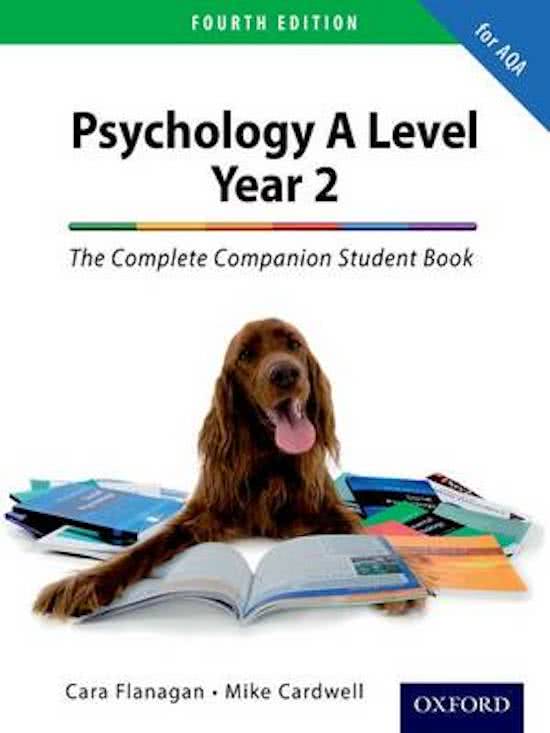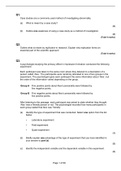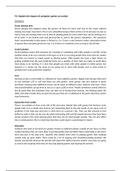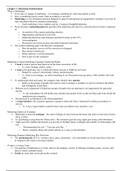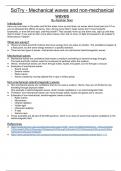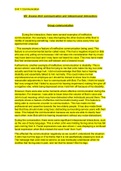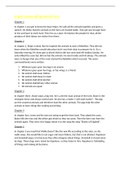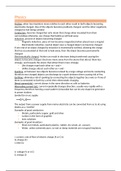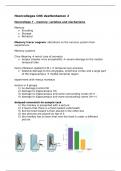Q1.
Case studies are a commonly used method of investigating abnormality.
(a) What is meant by a case study?
(2)
(b) Outline one weakness of using a case study as a method of investigation.
(2)
(Total 4 marks)
Q2.
Outline what is meant by replication in research. Explain why replication forms an
essential part of the scientific approach.
(Total 4 marks)
Q3.
A psychologist studying the primacy effect in impression formation conducted the following
experiment.
Each participant was taken to the same room where they listened to a description of a
person called ’Alex’. The participants were randomly allocated to one of two groups in the
experiment. The psychologist gave each participant the same information about ’Alex’, but
the order of the information varied depending on the group.
Group A Five positive points about Alex’s personality were followed by
five negative points.
Group B Five negative points about Alex’s personality were followed by
five positive points.
After listening to the passage, each participant was asked to state whether they thought
’Alex’ was a friendly person or not. The psychologist recorded how many participants in
each group stated that Alex was ’friendly’.
(a) Identify the type of experiment that was conducted. Select one option from the list
below.
• Laboratory experiment
• Field experiment
• Quasi-experiment
(1)
(b) Briefly explain one advantage of the type of experiment that you have identified in
your answer to part (a).
(2)
(c) Identify the independent variable and the dependent variable in this experiment.
(2)
Page 1 of 69
, (d) Identify the experimental design used in this study.
(1)
(Total 6 marks)
Q4.
A psychologist studying obedience conducted the following experiment.
A confederate (stooge) approached people in the street and instructed them to pick up a
piece of litter and put it in a nearby bin. None of the people approached had dropped the
litter.
There were two groups in the experiment.
Group A The confederate (stooge) was dressed in everyday clothing.
Group B The confederate (stooge) was dressed in a uniform.
The psychologist recorded how many people in each group obeyed the instruction of the
confederate (stooge).
(a) Identify the experimental design that was used in this study. Briefly explain one
advantage of using this experimental design in this study.
(3)
(b) Identify the independent variable and the dependent variable in this experiment.
(2)
(c) Use your knowledge of research into obedience to explain the likely outcome of this
experiment.
(3)
(d) Briefly outline one ethical issue that might have arisen in this experiment.
(2)
(Total 10 marks)
Q5.
A psychologist wanted to investigate whether or not people are influenced by the opinions
of others.
The psychologist selected 100 pupils from a secondary school to be participants in the
study.
The psychologist showed participants a cake which weighed 350 grams. The task for the
participants was to estimate the weight of the cake in grams.
Participants were allocated randomly to one of two groups.
In Group A, 50 participants were asked individually to estimate the weight of the cake.
The psychologist gave each participant a blank piece of paper on which to write his or her
estimate.
In Group B, the other 50 participants were asked individually to estimate the weight of the
cake. This time, the psychologist gave each participant a piece of paper which contained
a list of five weights (493 grams, 512 grams, 502 grams, 485 grams and 601 grams). The
Page 2 of 69
,participants were told that these were the estimates given by five people and that they
should write their own estimate below these other estimates.
The psychologist expected that participants in Group B would be influenced by the five
other estimates. She expected that they would write down a weight similar to the five
estimates on the piece of paper.
The median estimates for the weight of the cake are shown in the table below.
The median estimate for the weight of the cake (in grams) in Group A and Group B
Group A Group B
Estimate written on a blank Estimate written below the
piece of paper list of five other estimates
The median
estimate of the
348 510
weight of the
cake (in grams)
(a) What might the psychologist conclude from the median scores shown in the table
above?
Explain your answer.
(2)
(b) Identify the independent variable and the dependent variable in this study.
(2)
(c) Explain how stratified sampling might have been used to select the participants in
this study.
(3)
(d) (i) The psychologist allocated the participants randomly to the two groups that
were used in this study.
Explain how the psychologist could have allocated the participants randomly
to the two groups.
(2)
(d) (ii) Briefly explain one reason why random allocation of participants is important.
(2)
(e) The psychologist used an independent groups design in this study.
Explain one reason why it would not have been appropriate to use a repeated
measures design in this study.
(2)
(f) Identify and briefly explain one ethical issue that the psychologist should have
considered in this study.
(3)
(g) (i) After the study, the psychologist interviewed some of the participants in Group
B.
Outline one type of interview that she might have conducted.
Page 3 of 69
, (2)
(g) (ii) Explain one limitation of the type of interview that you have outlined in your
answer to (g)(i).
(2)
(Total 20 marks)
Q6.
A maths teacher wondered whether there was a relationship between mathematical ability
and musical ability. She decided to test this out on the GCSE students in the school. From
210 students, she randomly selected 10 and gave each of them two tests. She used part
of a GCSE exam paper to test their mathematical ability. The higher the mark, the better
the mathematical ability. She could not find a musical ability test so she devised her own.
She asked each student to sing a song of their choice. She then rated their performance
on a scale of 1–10, where 1 is completely tuneless and 10 is in perfect tune.
(a) Suggest a suitable non-directional hypothesis for this study.
(3)
(b) Why might the measure of musical ability used by the teacher lack validity?
(3)
(c) Explain how the teacher could have checked the reliability of the mathematical
ability test.
(3)
(d) Explain why the teacher chose to use a random sample in this study.
The results of the study are given in the table below.
Mathematical ability test scores and musical ability ratings for 10 students
Student Mathematical ability Musical ability
test score rating
1 10 10
2 2 9
3 9 3
4 6 6
5 3 9
6 10 2
7 2 1
8 1 8
9 8 4
10 4 7
Page 4 of 69
Case studies are a commonly used method of investigating abnormality.
(a) What is meant by a case study?
(2)
(b) Outline one weakness of using a case study as a method of investigation.
(2)
(Total 4 marks)
Q2.
Outline what is meant by replication in research. Explain why replication forms an
essential part of the scientific approach.
(Total 4 marks)
Q3.
A psychologist studying the primacy effect in impression formation conducted the following
experiment.
Each participant was taken to the same room where they listened to a description of a
person called ’Alex’. The participants were randomly allocated to one of two groups in the
experiment. The psychologist gave each participant the same information about ’Alex’, but
the order of the information varied depending on the group.
Group A Five positive points about Alex’s personality were followed by
five negative points.
Group B Five negative points about Alex’s personality were followed by
five positive points.
After listening to the passage, each participant was asked to state whether they thought
’Alex’ was a friendly person or not. The psychologist recorded how many participants in
each group stated that Alex was ’friendly’.
(a) Identify the type of experiment that was conducted. Select one option from the list
below.
• Laboratory experiment
• Field experiment
• Quasi-experiment
(1)
(b) Briefly explain one advantage of the type of experiment that you have identified in
your answer to part (a).
(2)
(c) Identify the independent variable and the dependent variable in this experiment.
(2)
Page 1 of 69
, (d) Identify the experimental design used in this study.
(1)
(Total 6 marks)
Q4.
A psychologist studying obedience conducted the following experiment.
A confederate (stooge) approached people in the street and instructed them to pick up a
piece of litter and put it in a nearby bin. None of the people approached had dropped the
litter.
There were two groups in the experiment.
Group A The confederate (stooge) was dressed in everyday clothing.
Group B The confederate (stooge) was dressed in a uniform.
The psychologist recorded how many people in each group obeyed the instruction of the
confederate (stooge).
(a) Identify the experimental design that was used in this study. Briefly explain one
advantage of using this experimental design in this study.
(3)
(b) Identify the independent variable and the dependent variable in this experiment.
(2)
(c) Use your knowledge of research into obedience to explain the likely outcome of this
experiment.
(3)
(d) Briefly outline one ethical issue that might have arisen in this experiment.
(2)
(Total 10 marks)
Q5.
A psychologist wanted to investigate whether or not people are influenced by the opinions
of others.
The psychologist selected 100 pupils from a secondary school to be participants in the
study.
The psychologist showed participants a cake which weighed 350 grams. The task for the
participants was to estimate the weight of the cake in grams.
Participants were allocated randomly to one of two groups.
In Group A, 50 participants were asked individually to estimate the weight of the cake.
The psychologist gave each participant a blank piece of paper on which to write his or her
estimate.
In Group B, the other 50 participants were asked individually to estimate the weight of the
cake. This time, the psychologist gave each participant a piece of paper which contained
a list of five weights (493 grams, 512 grams, 502 grams, 485 grams and 601 grams). The
Page 2 of 69
,participants were told that these were the estimates given by five people and that they
should write their own estimate below these other estimates.
The psychologist expected that participants in Group B would be influenced by the five
other estimates. She expected that they would write down a weight similar to the five
estimates on the piece of paper.
The median estimates for the weight of the cake are shown in the table below.
The median estimate for the weight of the cake (in grams) in Group A and Group B
Group A Group B
Estimate written on a blank Estimate written below the
piece of paper list of five other estimates
The median
estimate of the
348 510
weight of the
cake (in grams)
(a) What might the psychologist conclude from the median scores shown in the table
above?
Explain your answer.
(2)
(b) Identify the independent variable and the dependent variable in this study.
(2)
(c) Explain how stratified sampling might have been used to select the participants in
this study.
(3)
(d) (i) The psychologist allocated the participants randomly to the two groups that
were used in this study.
Explain how the psychologist could have allocated the participants randomly
to the two groups.
(2)
(d) (ii) Briefly explain one reason why random allocation of participants is important.
(2)
(e) The psychologist used an independent groups design in this study.
Explain one reason why it would not have been appropriate to use a repeated
measures design in this study.
(2)
(f) Identify and briefly explain one ethical issue that the psychologist should have
considered in this study.
(3)
(g) (i) After the study, the psychologist interviewed some of the participants in Group
B.
Outline one type of interview that she might have conducted.
Page 3 of 69
, (2)
(g) (ii) Explain one limitation of the type of interview that you have outlined in your
answer to (g)(i).
(2)
(Total 20 marks)
Q6.
A maths teacher wondered whether there was a relationship between mathematical ability
and musical ability. She decided to test this out on the GCSE students in the school. From
210 students, she randomly selected 10 and gave each of them two tests. She used part
of a GCSE exam paper to test their mathematical ability. The higher the mark, the better
the mathematical ability. She could not find a musical ability test so she devised her own.
She asked each student to sing a song of their choice. She then rated their performance
on a scale of 1–10, where 1 is completely tuneless and 10 is in perfect tune.
(a) Suggest a suitable non-directional hypothesis for this study.
(3)
(b) Why might the measure of musical ability used by the teacher lack validity?
(3)
(c) Explain how the teacher could have checked the reliability of the mathematical
ability test.
(3)
(d) Explain why the teacher chose to use a random sample in this study.
The results of the study are given in the table below.
Mathematical ability test scores and musical ability ratings for 10 students
Student Mathematical ability Musical ability
test score rating
1 10 10
2 2 9
3 9 3
4 6 6
5 3 9
6 10 2
7 2 1
8 1 8
9 8 4
10 4 7
Page 4 of 69

